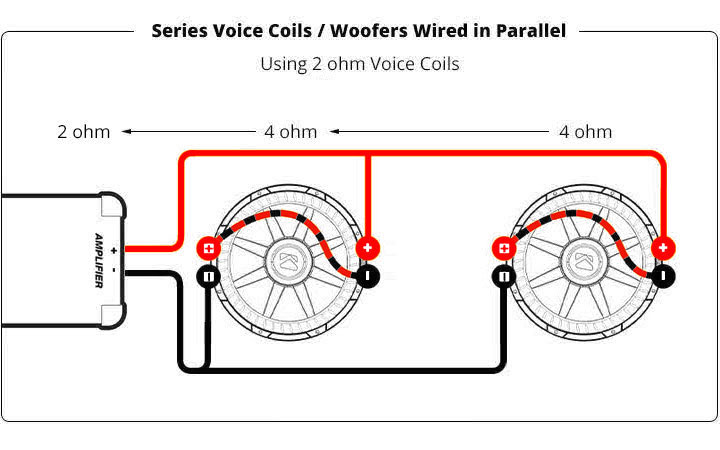Double the Bass Connecting Two 4 Ohm Subwoofers

Want to truly feel the bass? Adding a second subwoofer can dramatically enhance your car audio experience. But simply plugging in another sub isn't enough; you need to wire it correctly. This guide dives deep into connecting two 4 ohm subwoofers, explaining the process and its nuances to ensure you achieve maximum bass impact without damaging your equipment.
Wiring two subwoofers opens up a world of powerful, room-shaking (or in this case, car-shaking) bass. Whether you're aiming for ground-shaking lows or just want to enrich your music's depth, understanding the proper techniques for connecting dual 4 ohm subs is crucial. This isn't as simple as plugging in an extra speaker; impedance plays a critical role in ensuring your amplifier and subwoofers work in harmony.
The core concept to grasp when connecting multiple subwoofers is impedance matching. Impedance, measured in ohms (Ω), is the resistance to the flow of electrical current. Your amplifier is designed to operate within a specific impedance range, and connecting subwoofers with the wrong combined impedance can overload your amp, potentially damaging it or the subwoofers. With two 4 ohm subwoofers, you can achieve different final impedance loads depending on how you wire them.
Historically, connecting multiple subwoofers has been a popular way to enhance car audio systems. Early car audio enthusiasts experimented with various wiring configurations to maximize their bass output. This led to the development of standardized wiring practices and the understanding of impedance matching. Today, connecting dual subwoofers is a common practice, facilitated by advancements in amplifier and subwoofer technology.
The main issue when connecting two 4 ohm subs is achieving the correct final impedance to match your amplifier's specifications. Wiring them in series results in an 8 ohm load, while wiring them in parallel creates a 2 ohm load. Many amplifiers are stable at both 2 ohms and 4 ohms but not always at 8 ohms. Choosing the wrong configuration can lead to insufficient power delivery to the subwoofers or even amplifier damage. This is why understanding the principles of series and parallel wiring is so critical.
Wiring in series means connecting the subwoofers one after the other, like a chain. The positive terminal of one sub connects to the amplifier, and its negative terminal connects to the positive terminal of the second sub. The negative terminal of the second sub then connects to the amplifier. This sums the impedance, resulting in 8 ohms with two 4 ohm subs.
Wiring in parallel means connecting both positive terminals of the subwoofers together and both negative terminals together. These combined positive and negative leads then connect to the amplifier. This divides the impedance, resulting in a 2 ohm load with two 4 ohm subs.
Benefits of properly wiring two 4-ohm subwoofers include increased bass output (more cone area moving air), improved power handling (distributing the power load), and potentially better sound quality (smoother bass response).
Step-by-step guide for wiring in parallel:
1. Connect the positive terminal of the amplifier to the positive terminal of the first subwoofer.
2. Connect the positive terminal of the first subwoofer to the positive terminal of the second subwoofer.
3. Connect the negative terminal of the amplifier to the negative terminal of the first subwoofer.
4. Connect the negative terminal of the first subwoofer to the negative terminal of the second subwoofer.
Advantages and Disadvantages of Wiring Two 4 Ohm Subs
| Advantages | Disadvantages |
|---|---|
| Increased bass output | Increased current draw on the amplifier |
| Improved power handling | Potential for amplifier overheating or damage if improperly wired |
| Potentially better sound quality | Requires careful impedance matching |
FAQ:
1. What gauge wire should I use? - Use a wire gauge appropriate for the power your amplifier is delivering. Consult a wire gauge chart for specifics.
2. Can I mix different ohm subwoofers? - It's generally recommended to use identical subwoofers for optimal performance. Mixing can lead to uneven power distribution.
3. What if my amplifier isn't 2-ohm stable? - Wiring your 4-ohm subs in series (resulting in an 8-ohm load) may be an option, but check your amplifier's specifications.
4. How can I tell if my amplifier is overheating? - Signs of overheating include a burning smell, distorted sound, or the amplifier shutting off.
5. Do I need a special amplifier for two subwoofers? - Not necessarily, but your amplifier must be able to handle the combined impedance of your subwoofers.
6. Can I wire more than two subwoofers? - Yes, but the impedance calculations become more complex and careful planning is essential.
7. What happens if I wire the subwoofers incorrectly? - You risk damaging your amplifier or the subwoofers.
8. Where can I find more information on subwoofer wiring? - Online car audio forums and websites offer detailed guides and diagrams.
Tips and tricks: Always double-check your wiring before powering on your system. Use a multimeter to verify your final impedance if you are unsure.
Connecting two 4 ohm subwoofers can significantly enhance your audio experience. By understanding the principles of impedance matching and following the appropriate wiring techniques, you can unlock the full potential of your car audio system. Correctly wiring your subwoofers not only increases bass output and power handling but also protects your equipment from potential damage. From choosing the correct wiring configuration to troubleshooting potential issues, this guide has equipped you with the knowledge to achieve the powerful, rich bass you crave. So, take the time to plan your wiring, double-check your connections, and get ready to enjoy your music on a whole new level. Remember, a well-wired system is a happy system!
Saddlebrooke two tucson az your ultimate guide
Unleashing the power retribution paladin stat priorities
Kelsey lawrence the dabb fan bus video phenomenon












